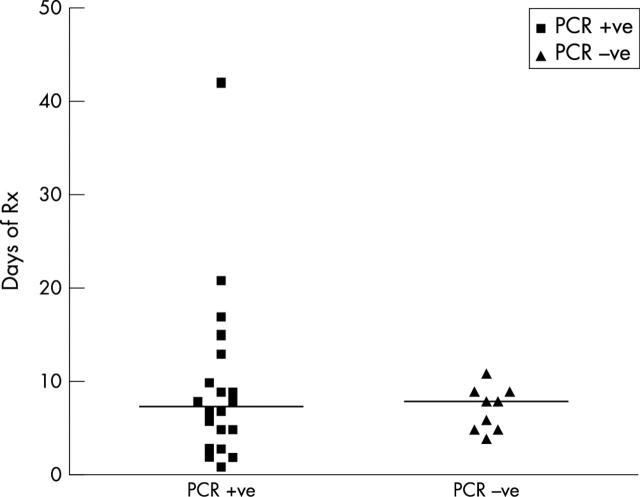Abstract
Background: An increase in the incidence of thoracic empyema in children has been reported. The causative pathogen is often unknown as pleural fluid is frequently sterile at the time of culture. The role of unusual organisms is unclear.
Aims: (1) To compare the detection of organisms in pleural fluid from children with empyema using a molecular technique (16S rDNA polymerase chain reaction (PCR)) and bacterial culture. (2) To compare the concordance of organisms identified using the two techniques and the influence of prior antibiotic treatment on positive detection rate.
Methods: Pleural fluid from children admitted with empyema between January 2000 and February 2002 was cultured and additionally analysed using broad range 16S rDNA PCR.
Results: Pleural fluid was cultured from 32 patients, aged 1 month–16 years. Median duration of previous antibiotic therapy was 8 days (range 1–42 days). Six samples were culture positive and 22 were PCR positive. A causal organism was detected by PCR alone, after considering results from the local hospital, in 14 patients. There was complete concordance in organisms cultured and detected by PCR. Additional organisms detected by PCR were predominantly S pneumoniae, S pyogenes, and anaerobes.
Conclusions: Analysis of pleural fluid by broad range 16S rDNA PCR in addition to culture, increases organism identification in empyema.
Full Text
The Full Text of this article is available as a PDF (187.9 KB).
Figure 1.
PCR results in relation to duration of previous antibiotic therapy in 32 samples (data missing from three patients).
Selected References
These references are in PubMed. This may not be the complete list of references from this article.
- Buckingham Steven C., King Michaela D., Miller Martha L. Incidence and etiologies of complicated parapneumonic effusions in children, 1996 to 2001. Pediatr Infect Dis J. 2003 Jun;22(6):499–504. doi: 10.1097/01.inf.0000069764.41163.8f. [DOI] [PubMed] [Google Scholar]
- Byington Carrie L., Spencer LaShonda Y., Johnson Timothy A., Pavia Andrew T., Allen Daniel, Mason Edward O., Kaplan Sheldon, Carroll Karen C., Daly Judy A., Christenson John C. An epidemiological investigation of a sustained high rate of pediatric parapneumonic empyema: risk factors and microbiological associations. Clin Infect Dis. 2002 Jan 3;34(4):434–440. doi: 10.1086/338460. [DOI] [PubMed] [Google Scholar]
- Chen K. Y., Hsueh P. R., Liaw Y. S., Yang P. C., Luh K. T. A 10-year experience with bacteriology of acute thoracic empyema: emphasis on Klebsiella pneumoniae in patients with diabetes mellitus. Chest. 2000 Jun;117(6):1685–1689. doi: 10.1378/chest.117.6.1685. [DOI] [PubMed] [Google Scholar]
- Davies R. J., Traill Z. C., Gleeson F. V. Randomised controlled trial of intrapleural streptokinase in community acquired pleural infection. Thorax. 1997 May;52(5):416–421. doi: 10.1136/thx.52.5.416. [DOI] [PMC free article] [PubMed] [Google Scholar]
- Eltringham Gary, Kearns Angela, Freeman Roger, Clark Julia, Spencer David, Eastham Katherine, Harwood Jayne, Leeming John. Culture-negative childhood empyema is usually due to penicillin-sensitive Streptococcus pneumoniae capsular serotype 1. J Clin Microbiol. 2003 Jan;41(1):521–522. doi: 10.1128/JCM.41.1.521-522.2003. [DOI] [PMC free article] [PubMed] [Google Scholar]
- Hardie W., Bokulic R., Garcia V. F., Reising S. F., Christie C. D. Pneumococcal pleural empyemas in children. Clin Infect Dis. 1996 Jun;22(6):1057–1063. doi: 10.1093/clinids/22.6.1057. [DOI] [PubMed] [Google Scholar]
- Harris Kathryn A., Fidler Katy J., Hartley John C., Vogt Julie, Klein Nigel J., Monsell Fergal, Novelli Vas M. Unique case of Helicobacter sp. osteomyelitis in an immunocompetent child diagnosed by broad-range 16S PCR. J Clin Microbiol. 2002 Aug;40(8):3100–3103. doi: 10.1128/JCM.40.8.3100-3103.2002. [DOI] [PMC free article] [PubMed] [Google Scholar]
- Harris Kathryn A., Hartley John C. Development of broad-range 16S rDNA PCR for use in the routine diagnostic clinical microbiology service. J Med Microbiol. 2003 Aug;52(Pt 8):685–691. doi: 10.1099/jmm.0.05213-0. [DOI] [PubMed] [Google Scholar]
- Lu J. J., Perng C. L., Lee S. Y., Wan C. C. Use of PCR with universal primers and restriction endonuclease digestions for detection and identification of common bacterial pathogens in cerebrospinal fluid. J Clin Microbiol. 2000 Jun;38(6):2076–2080. doi: 10.1128/jcm.38.6.2076-2080.2000. [DOI] [PMC free article] [PubMed] [Google Scholar]
- Munglani R., Kenney I. J. Paediatric parapneumonic effusions: a review of 16 cases. Respir Med. 1991 Mar;85(2):117–119. doi: 10.1016/s0954-6111(06)80288-x. [DOI] [PubMed] [Google Scholar]
- Nikkari Simo, Lopez Fred A., Lepp Paul W., Cieslak Paul R., Ladd-Wilson Stephen, Passaro Douglas, Danila Richard, Relman David A. Broad-range bacterial detection and the analysis of unexplained death and critical illness. Emerg Infect Dis. 2002 Feb;8(2):188–194. doi: 10.3201/eid0802.010150. [DOI] [PMC free article] [PubMed] [Google Scholar]
- O'Neill A. M., Gillespie S. H., Whiting G. C. Detection of penicillin susceptibility in Streptococcus pneumoniae by pbp2b PCR-restriction fragment length polymorphism analysis. J Clin Microbiol. 1999 Jan;37(1):157–160. doi: 10.1128/jcm.37.1.157-160.1999. [DOI] [PMC free article] [PubMed] [Google Scholar]
- Rantakokko-Jalava K., Nikkari S., Jalava J., Eerola E., Skurnik M., Meurman O., Ruuskanen O., Alanen A., Kotilainen E., Toivanen P. Direct amplification of rRNA genes in diagnosis of bacterial infections. J Clin Microbiol. 2000 Jan;38(1):32–39. doi: 10.1128/jcm.38.1.32-39.2000. [DOI] [PMC free article] [PubMed] [Google Scholar]
- Rees J. H., Spencer D. A., Parikh D., Weller P. Increase in incidence of childhood empyema in West Midlands, UK. Lancet. 1997 Feb 8;349(9049):402–402. doi: 10.1016/s0140-6736(97)80022-0. [DOI] [PubMed] [Google Scholar]
- Thompson A., Reid A., Shields M., Steen H., Taylor R. Increased incidence in childhood empyema thoracis in Northern Ireland. Ir Med J. 1999 Nov-Dec;92(7):438–438. [PubMed] [Google Scholar]
- Thomson A. H., Hull J., Kumar M. R., Wallis C., Balfour Lynn I. M. Randomised trial of intrapleural urokinase in the treatment of childhood empyema. Thorax. 2002 Apr;57(4):343–347. doi: 10.1136/thorax.57.4.343. [DOI] [PMC free article] [PubMed] [Google Scholar]
- Trotha R., Hanck T., König W., König B. Rapid ribosequencing--an effective diagnostic tool for detecting microbial infection. Infection. 2001 Jan-Feb;29(1):12–16. doi: 10.1007/s15010-001-0064-7. [DOI] [PubMed] [Google Scholar]
- Yamamoto Yoshimasa. PCR in diagnosis of infection: detection of bacteria in cerebrospinal fluids. Clin Diagn Lab Immunol. 2002 May;9(3):508–514. doi: 10.1128/CDLI.9.3.508-514.2002. [DOI] [PMC free article] [PubMed] [Google Scholar]



